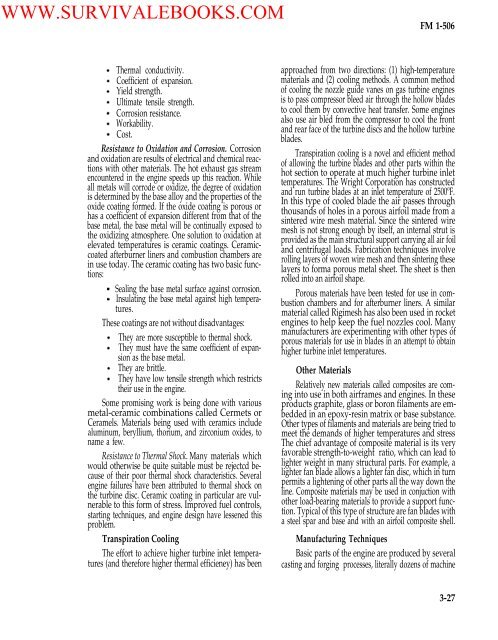FM 1-506 Fundamentals of Aircraft Power Plants ... - Survival Books
FM 1-506 Fundamentals of Aircraft Power Plants ... - Survival Books
FM 1-506 Fundamentals of Aircraft Power Plants ... - Survival Books
You also want an ePaper? Increase the reach of your titles
YUMPU automatically turns print PDFs into web optimized ePapers that Google loves.
WWW.SURVIVALEBOOKS.COM<strong>FM</strong> 1-<strong>506</strong>Thermal conductivity.Coefficient <strong>of</strong> expansion.Yield strength.Ultimate tensile strength.Corrosion resistance.Workability.Cost.Resistance to Oxidation and Corrosion. Corrosionand oxidation are results <strong>of</strong> electrical and chemical reactionswith other materials. The hot exhaust gas streamencountered in the engine speeds up this reaction. Whileall metals will corrode or oxidize, the degree <strong>of</strong> oxidationis determined by the base alloy and the properties <strong>of</strong> theoxide coating formed. If the oxide coating is porous orhas a coefficient <strong>of</strong> expansion different from that <strong>of</strong> thebase metal, the base metal will be continually exposed tothe oxidizing atmosphere. One solution to oxidation atelevated temperatures is ceramic coatings. Ceramiccoatedafterburner liners and combustion chambers arein use today. The ceramic coating has two basic functions:Sealing the base metal surface against corrosion.Insulating the base metal against high temperatures.These coatings are not without disadvantages:They are more susceptible to thermal shock.They must have the same coefficient <strong>of</strong> expansion as the base metal.They are brittle.They have low tensile strength which restrictstheir use in the engine.Some promising work is being done with variousmetal-ceramic combinations called Cermets orCeramels. Materials being used with ceramics includealuminum, beryllium, thorium, and zirconium oxides, toname a few.Resistance to Thermal Shock. Many materials whichwould otherwise be quite suitable must be rejectcd because<strong>of</strong> their poor thermal shock characteristics. Severalengine failures have been attributed to thermal shock onthe turbine disc. Ceramic coating in particular are vulnerableto this form <strong>of</strong> stress. Improved fuel controls,starting techniques, and engine design have lessened thisproblem.Transpiration CoolingThe effort to achieve higher turbine inlet temperatures(and therefore higher thermal efficieney) has beenapproached from two directions: (1) high-temperaturematerials and (2) cooling methods. A common method<strong>of</strong> cooling the nozzle guide vanes on gas turbine enginesis to pass compressor bleed air through the hollow bladesto cool them by convective heat transfer. Some enginesalso use air bled from the compressor to cool the frontand rear face <strong>of</strong> the turbine discs and the hollow turbineblades.Transpiration cooling is a novel and efficient method<strong>of</strong> allowing the turbine blades and other parts within thehot section to operate at much higher turbine inlettemperatures. The Wright Corporation has constructedand run turbine blades at an inlet temperature <strong>of</strong> 2500ºF.In this type <strong>of</strong> cooled blade the air passes throughthousands <strong>of</strong> holes in a porous airfoil made from asintered wire mesh material. Since the sintered wiremesh is not strong enough by itself, an internal strut isprovided as the main structural support carrying all air foiland centrifugal loads. Fabrication techniques involverolling layers <strong>of</strong> woven wire mesh and then sintering theselayers to forma porous metal sheet. The sheet is thenrolled into an airfoil shape.Porous materials have been tested for use in combustionchambers and for afterburner liners. A similarmaterial called Rigimesh has also been used in rocketengines to help keep the fuel nozzles cool. Manymanufacturers are experimenting with other types <strong>of</strong>porous materials for use in blades in an attempt to obtainhigher turbine inlet temperatures.Other MaterialsRelatively new materials called composites are cominginto use in both airframes and engines. In theseproducts graphite, glass or boron filaments are embeddedin an epoxy-resin matrix or base substance.Other types <strong>of</strong> filaments and materials are being tried tomeet the demands <strong>of</strong> higher temperatures and stressThe chief advantage <strong>of</strong> composite material is its veryfavorable strength-to-weight ratio, which can lead tolighter weight in many structural parts. For example, alighter fan blade allows a lighter fan disc, which in turnpermits a lightening <strong>of</strong> other parts all the way down theline. Composite materials may be used in conjuction withother load-bearing materials to provide a support function.Typical <strong>of</strong> this type <strong>of</strong> structure are fan blades witha steel spar and base and with an airfoil composite shell.Manufacturing TechniquesBasic parts <strong>of</strong> the engine are produced by severalcasting and forging processes, literally dozens <strong>of</strong> machine3-27
















